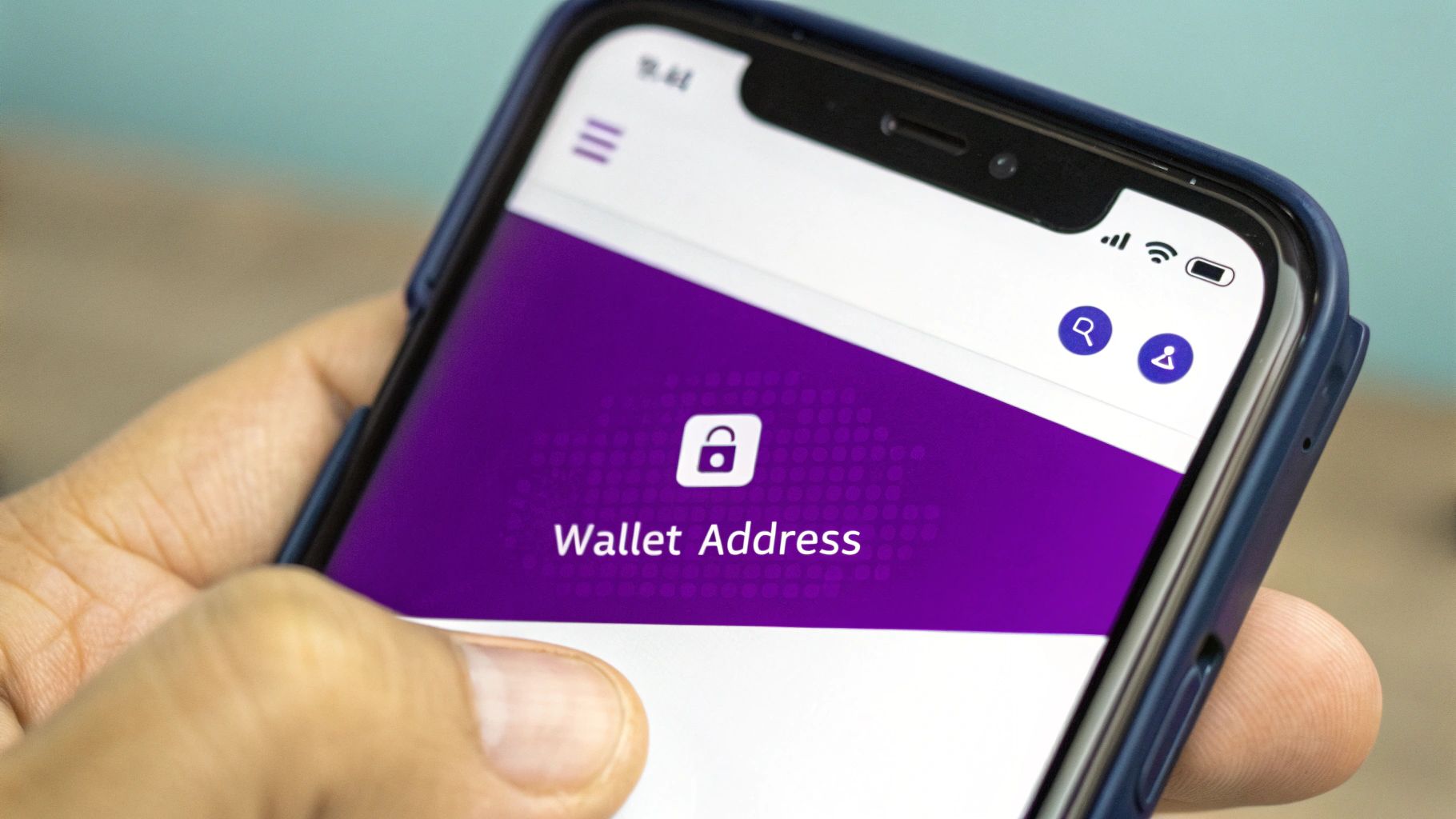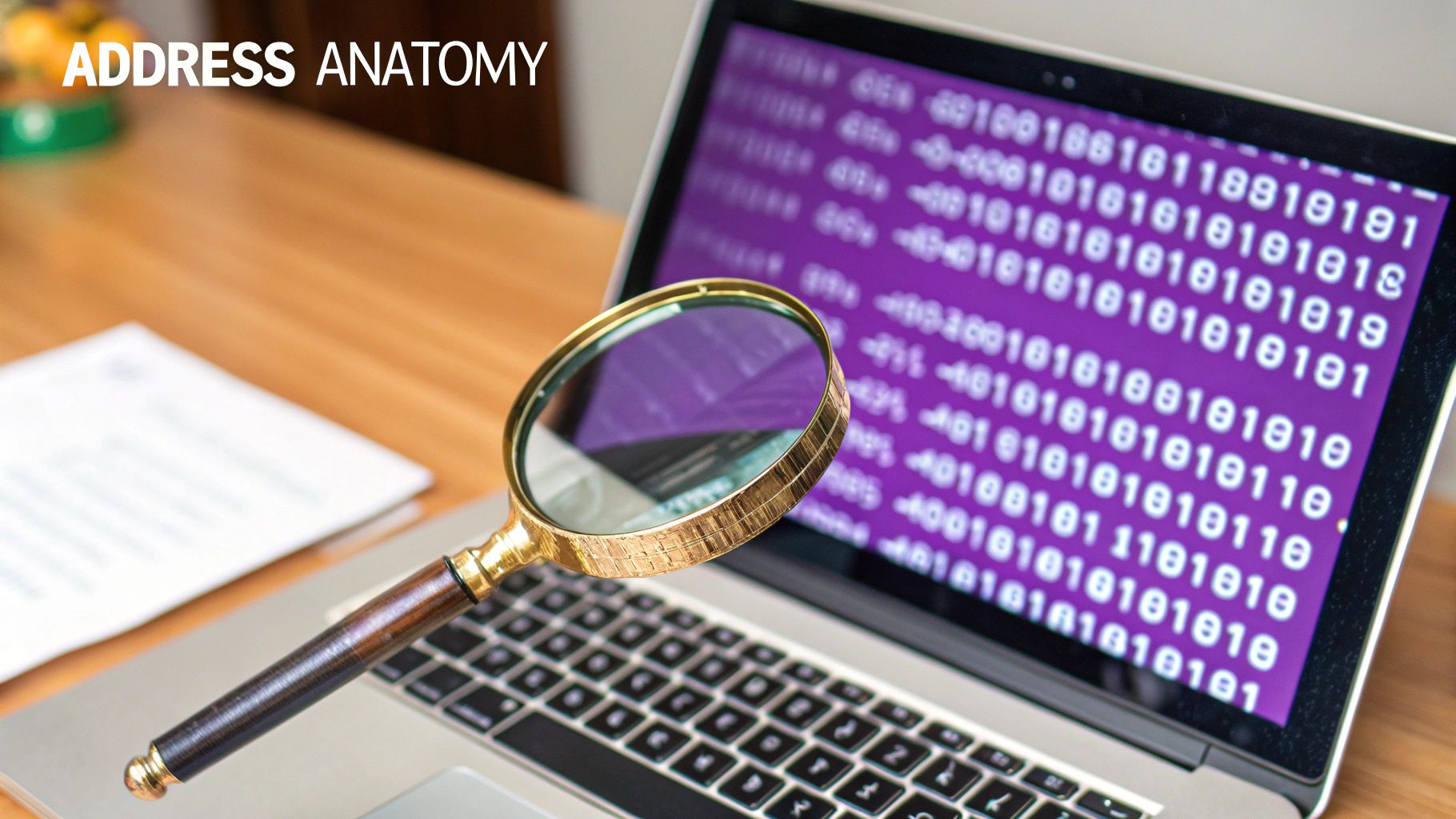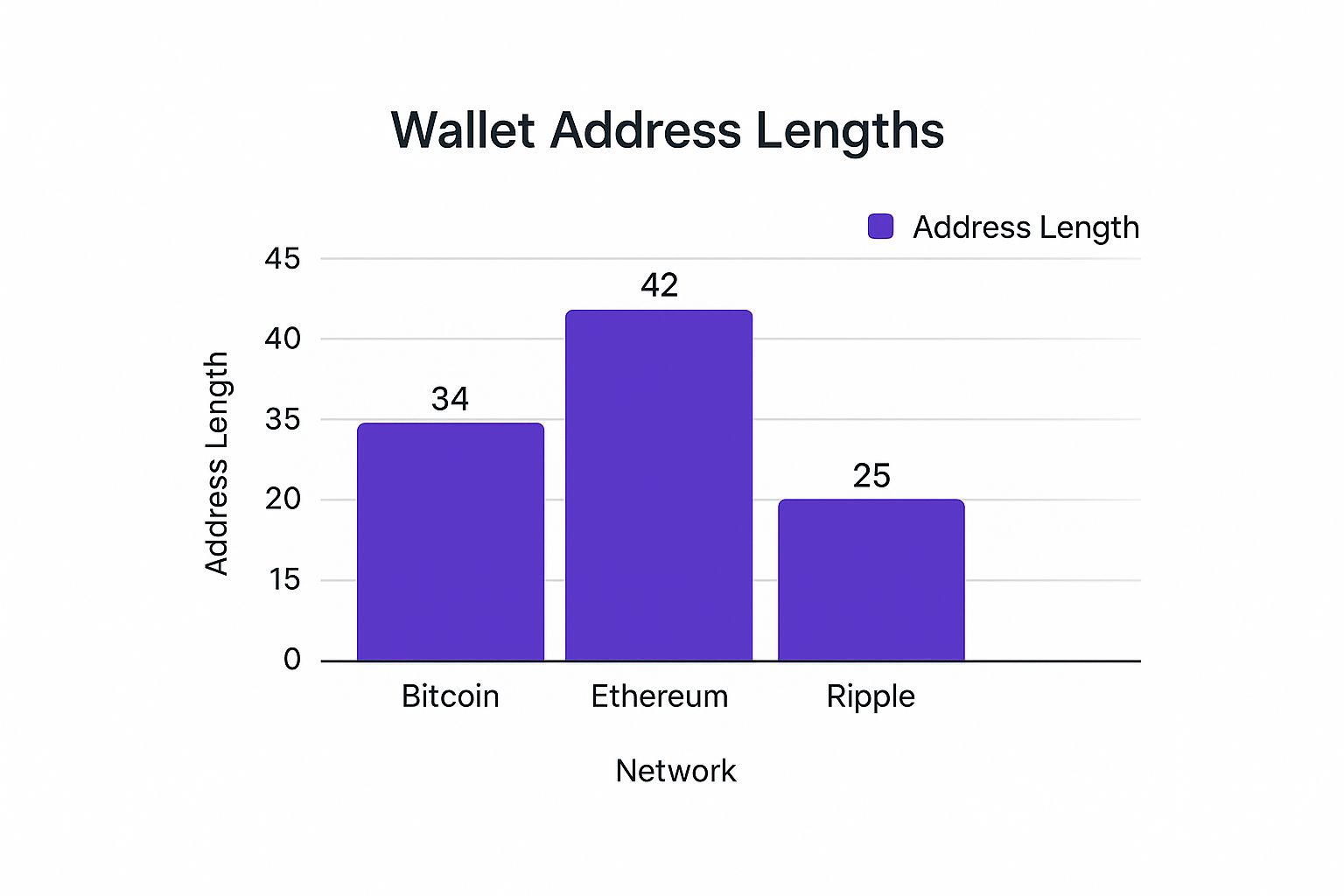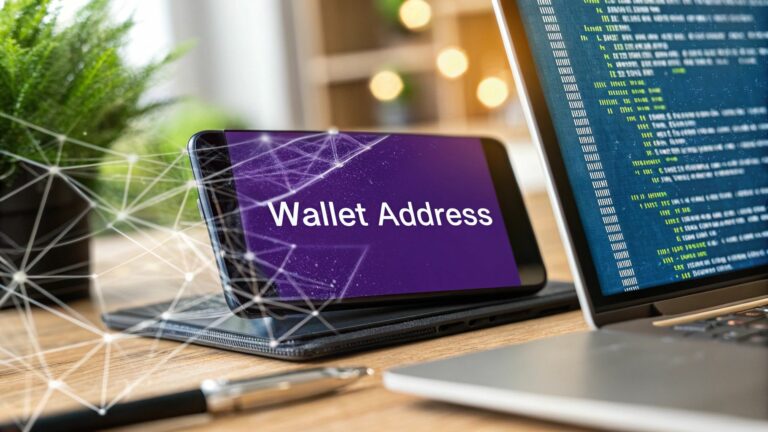If you're new to crypto, one of the first things you'll encounter is the wallet address. The simplest way to think about it is like a bank account number, but for your digital money. It’s a unique string of characters that you can share with anyone, anywhere in the world, so they can send you cryptocurrency.
But here’s the most important part: while you can share your address freely, you must never share the private key that goes with it. That key is your password, the only thing that gives you access to your funds.
Your Crypto Address Explained With a Simple Analogy

Let's try a real-world comparison. Picture a secure mailbox out on the street—that’s your crypto wallet living on the blockchain. The address printed on the front of that mailbox is your wallet address. Anyone can see it and use it to drop mail (or crypto) inside.
But only you have the key to unlock that mailbox and get what’s inside. That special key is your private key. Grasping this distinction is absolutely fundamental for anyone starting their crypto journey.
- Wallet Address (Public): This is your receiving ID. It's completely safe to share.
- Private Key (Secret): This is your master password. Keep it secret, keep it safe.
A wallet address is nothing more than a destination on the blockchain. It's a jumble of letters and numbers telling the network where to send the coins. Sharing it is just like giving someone your P.O. box number—they can put things in, but they can't take anything out.
Putting Address Activity Into Perspective
While countless wallet addresses are generated every day, not all of them are in active use. Take Bitcoin, for example. Over 200 million addresses have been created throughout its history, yet only around 25 million are considered active and held by individuals.
The rest often sit dormant or belong to large entities like crypto exchanges. It just goes to show that a single person can have multiple addresses for different coins or purposes, much like having different bank accounts. For more deep-dives into crypto usage, Chainalysis offers some fantastic reports.
This separation between public addresses and private keys is the core principle that keeps cryptocurrency secure. As you start looking at a wallet address example for different coins, you'll see this same fundamental idea at play. If you're ready to build on these core concepts, the vTrader Academy is packed with resources to guide you.
Breaking Down the Anatomy of a Wallet Address

At first glance, a crypto wallet address looks like a random mess of letters and numbers. But there’s a method to the madness—it’s actually a brilliant piece of cryptographic engineering built for security and accuracy.
This string isn’t just pulled out of thin air. It’s derived directly from your wallet’s public key using a special one-way hashing process. Think of the public key as the raw iron ore and the address as the finished, polished steel key you can share with anyone.
Crucially, this process is irreversible. No one can ever reverse-engineer your address to find your public key, adding a powerful layer of security to your funds. Every single character is there for a reason, ensuring your crypto lands exactly where it’s supposed to go.
The Core Components of an Address
Two of the most critical parts of any wallet address are its prefix and its checksum. These features are baked right into the address, and they’re essential for how different blockchains work and, more importantly, for protecting you from costly mistakes.
-
The Prefix: This is simply the first few characters of the address, and it acts as a network identifier. For example, legacy Bitcoin addresses always start with a "1," while almost every Ethereum address kicks off with "0x." This simple feature prevents you from accidentally trying to send, say, Bitcoin to an Ethereum wallet—a mistake that could cause you to lose your funds forever. You can see the "0x" prefix in action by checking out this Ethereum price and network data.
-
The Checksum: This is a clever, built-in error-detection tool. It's a tiny bit of data that’s calculated from the rest of the address string. If you accidentally mistype even a single character when sending funds, the checksum will no longer match. Your wallet software will instantly flag the address as invalid, stopping the transaction in its tracks.
This built-in validation is like a spell-checker for your money. It's the reason why a simple typo doesn't result in your crypto being sent into a digital black hole. Without it, the risk of human error would be catastrophic.
These components work together to ensure that every wallet address example you see is a secure and verifiable destination for your digital assets.
Common Wallet Address Examples and Formats
It's one thing to understand the theory behind a crypto wallet address, but seeing them in the wild is what really makes the concept click. Different blockchains have their own unique address formats, each with little tell-tale signs that act like a country code for your digital cash. Once you get the hang of spotting these patterns, you'll be able to tell which network an address belongs to at a glance.
This isn't just trivia—it's a critical skill for avoiding costly mistakes, like sending your crypto to the wrong blockchain. Let's break down some of the most common formats you’ll run into.
Bitcoin Address Formats
As the granddaddy of crypto, Bitcoin has gone through a few upgrades over the years, resulting in several different address types. You don't need a PhD in cryptography to understand them, but knowing how to spot the difference is a huge advantage.
- Legacy (P2PKH): These are the OG Bitcoin addresses. They always start with the number 1. For example:
1BvBMSEYstWetqTFn5Au4m4GFg7xJaNVN2. - Script (P2SH): You’ll often see these used for more complex setups, like multi-sig wallets where multiple people need to approve a transaction. These addresses always begin with the number 3. For example:
3J98t1WpEZ73CNmQviecrnyiWrnqRhWNLy. - Native SegWit (Bech32): This is the modern, more efficient standard that helps keep transaction fees down. They’re easy to spot because they always start with bc1. For example:
bc1qar0srrr7xfkvy5l643lydnw9re59gtzzwf5mdq.
Getting familiar with these prefixes is a simple way to get more comfortable managing your assets. For a deeper dive into how it all works, check out our guide on Bitcoin (BTC) price, charts, and market data.
Ethereum and EVM-Compatible Chains
The format pioneered by Ethereum has become the go-to standard for a massive ecosystem of other blockchains, including big names like Polygon, Avalanche, and Binance Smart Chain. This makes it one of the most widespread address styles you'll encounter.
The beauty of it is the consistency. All standard Ethereum and EVM-compatible addresses are 42 characters long and always start with 0x. This universal structure makes it much simpler to move assets between these interconnected networks.
A classic Ethereum wallet address looks just like this: 0x71C7656EC7ab88b098defB751B7401B5f6d8976F.
The infographic below gives you a quick visual comparison of how address lengths stack up across a few of the major networks.

As you can see, Ethereum's addresses are quite a bit longer than those for Bitcoin or Ripple, which is a direct result of their unique cryptographic design.
Crypto Wallet Address Formats Compared
To make things even clearer, here’s a quick side-by-side look at the address formats for some of the biggest players in the crypto space.
| Cryptocurrency | Address Example | Typical Starting Characters | Key Feature |
|---|---|---|---|
| Bitcoin (BTC) | bc1qar0srrr7xfkvy5l643lydnw9re59gtzzwf5mdq |
1, 3, or bc1 |
Multiple formats exist, with bc1 being the most modern and efficient. |
| Ethereum (ETH) | 0x71C7656EC7ab88b098defB751B7401B5f6d8976F |
0x |
The standard for all EVM-compatible chains, making it highly versatile. |
| TRON (TRX) | TNYt1iCRtMch4z3F1d7pD2iLpQ3x3y3y3y |
T |
A single, easy-to-recognize format that starts with a capital "T". |
This table serves as a handy cheat sheet. Recognizing these small details can save you a lot of headaches when you're sending and receiving funds.
Other Popular Blockchain Addresses
Of course, the crypto world is huge, and so is the variety of address formats out there. Take TRON (TRX), for instance—its addresses always start with a capital "T". This network is an absolute powerhouse, especially for stablecoins and DeFi.
In fact, as of late 2024, TRON was seeing nearly 2.9 million active addresses every single day. That number completely dwarfs Bitcoin's daily average of around 887,000. By learning to spot these unique identifiers, you're building a practical skill set that will help you navigate the multi-chain universe with confidence.
How to Find and Share Your Wallet Address Securely
Getting your hands on your crypto wallet address is one of the first things you'll do, and thankfully, it's designed to be dead simple. Whether you're on a mobile app, browser extension, or a hardware wallet, the process is pretty much the same because it all centers around one core function: receiving crypto.
Most wallets make this incredibly easy. Just look for a big, obvious button that says "Receive" or "Deposit." Give that a tap, and you’ll instantly see your full public wallet address and its matching QR code—perfect for when you’re doing a transaction in person.
By 2025, crypto wallets have become a common tool, with internet-connected "hot wallets" dominating 78% of the market thanks to their sheer convenience. This is especially true for mobile-first wallets, which boast much higher user retention than their browser-based cousins. Discover more insights about these wallet adoption statistics.
Here’s what you can expect to see in a typical wallet, showing both the long string of characters and a scannable QR code.
The interface is built for clarity, almost always including a one-click copy icon so you can grab the address without making any mistakes.
Best Practices for Sharing Your Address
Once you have your address, sharing it safely is the name of the game. A small mistake here can be costly, so always stick to these simple but mission-critical rules to protect your funds.
- Always Copy and Paste: Whatever you do, don't try to type a wallet address out by hand. A single wrong character could send your funds into the digital void, never to be seen again.
- Double-Check the Ends: Before you hit send, quickly verify the first four and last four characters of the address you pasted. Does it match the recipient's? This simple check catches most copy-paste errors.
- Send a Small Test First: For any significant amount, it's a smart move to send a tiny "tester" transaction first. Once the other person confirms it arrived safely, you can send the rest with confidence.
- Use QR Codes When You Can: If you're standing next to the person you're transacting with, having them scan your QR code is the fastest and most foolproof way to share your address.
Following these habits will help you manage your crypto safely and sidestep the common traps that catch new users. For a deeper dive into transaction costs, you might want to check out our guide on the Ethereum Gas Tracker.
Costly Mistakes to Avoid When Handling Crypto Addresses
A simple slip-up with a crypto address can mean the permanent loss of your funds. Unlike a bank transfer you can recall, blockchain transactions are set in stone—making precision absolutely critical. Understanding the most common pitfalls is the first step toward keeping your assets safe.
One of the most devastating—and common—errors is sending funds to an incompatible blockchain. Imagine trying to mail a letter to an email address; it just won't work. Sending Bitcoin (BTC) to an Ethereum (ETH) wallet is the crypto equivalent. The systems don't speak the same language, and your crypto will be lost forever. Always double-check that the recipient's address is on the correct network for the coin you're sending.
Watch Out for Malicious Attacks
A far more sinister threat comes from clipboard-hijacking malware. This sneaky attack, known as address poisoning, quietly monitors your computer’s clipboard. When you copy a legitimate wallet address, the malware instantly swaps it with a scammer's address designed to look deceptively similar, often matching the first and last few characters.
If you don't meticulously verify the full address before confirming the transaction, you'll unknowingly send your funds straight to a thief. These attacks are on the rise, preying on our natural tendency to only glance at addresses instead of inspecting them closely.
The best defense is a simple, unbreakable habit: always double-check the first four and last four characters of any address you paste. Better yet, verify the entire string character by character before hitting send.
To lock down your funds, make these security habits non-negotiable:
- Never Manually Type an Address: The risk of a typo is just too high. Stick to the copy-paste function or scan a QR code.
- Send a Small Test Transaction: For any large or important transfer, send a tiny amount first. Wait for the recipient to confirm it arrived safely before sending the rest.
This two-step verification—checking the address and sending a test transaction—is a small price to pay for the massive protection it provides against costly, irreversible mistakes.
Frequently Asked Questions About Wallet Addresses
Even after you get the hang of how crypto addresses work, a few common questions always seem to pop up. Getting straight answers to these is the key to managing your digital assets with confidence.
Let's dive into some of the most common ones.
Is It Safe to Post My Public Address Online?
Yes, for the most part, it's safe to share your public wallet address. The best analogy is a P.O. box number—anyone can use it to send you mail, but they can't use it to take anything out. This is how you receive payments or donations without ever giving up sensitive info.
There is a catch, though: privacy. Since all transactions are public on the blockchain, anyone with your address can become a financial detective. They can see its entire history, including its current balance and every single transaction it has ever been a part of.
Why Use a New Address for Each Transaction?
Generating a new address for every payment you receive is a simple but powerful privacy habit. While you don't have to do it, this one small step makes it incredibly difficult for anyone to piece together your entire financial picture.
Luckily, most modern wallets do this for you automatically whenever you go to receive funds. This tactic effectively compartmentalizes your crypto, preventing one single address from becoming a public ledger of your entire portfolio.
By creating a fresh wallet address example for each incoming payment, you break the chain of association. This prevents observers from easily tracking your total wealth or spending habits by analyzing a single, heavily used address.
If you have more questions about platform specifics, you can explore the vTrader FAQ page for additional details.
What Happens If I Send Crypto to the Wrong Address?
This is the one you really need to pay attention to. Sending crypto to the wrong address almost always means those funds are gone for good. Blockchain transactions are irreversible by their very nature, and there’s no central bank to call to reverse the charge.
This is why you have to be meticulous. Always double-check, or even triple-check, the address before you hit send. Use your wallet’s copy-paste function and then verify the first few and last few characters to make sure everything matches up perfectly.
Ready to trade with confidence and zero fees? Join vTrader today and start building your crypto portfolio without paying any commissions on your trades. Get started now!

Steve Gregory is a lawyer in the United States who specializes in licensing for cryptocurrency companies and products. Steve began his career as an attorney in 2015 but made the switch to working in cryptocurrency full time shortly after joining the original team at Gemini Trust Company, an early cryptocurrency exchange based in New York City. Steve then joined CEX.io and was able to launch their regulated US-based cryptocurrency. Steve then went on to become the CEO at currency.com when he ran for four years and was able to lead currency.com to being fully acquired in 2025.


